This is part of a series offering my views on some problems with and solutions for UK maths education. The first part looked at the state of affairs with regards to GCSE and PISA results, the second part looked at my attempt at a diagnosis, the third part looked at pre-existing maths education success stories, the fourth part looked at how textbooks offer the largest potential to improve pedagogy across the nation, the fifth part examined the role of hard work and homework, and the sixth part diagnosed the problem of forgetting in maths education. This part examines one solution to improving maths memory: employing the spacing effect.

I remember it well. I’d reached the end of my first ever half term of teaching. But standing between me and the holidays was a large pile of assessments to mark. At first, the prospect didn’t seem too bad: I thought it would be relatively mindless work. But that belief was before I actually started the marking itself. My dreams of a mindless few hours rapidly transmogrified into a nightmare: the nightmare of realising how poorly my classes had done. Question after question hit me with the same realisation: ‘we’ve covered this in class – we even looked at this yesterday, in our revision lesson – how on earth did you get this question this wrong?’
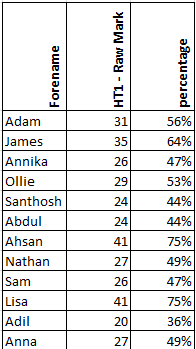
(scores are real, names have been changed)
The above table shows a representative sample of results from one class. Some pupils had turned in pretty good papers. But as a whole, across all my classes, the class average was pretty close to 50%. As a pupil myself, I could never have even comprehended getting 50% in a maths exam. As a teacher, I was even more baffled. I had taught 100% of the topics on the test – what on earth had happened to the other 50%?
Seeing my class results as a whole then pricked me with a deep fear. This was first half term as a teacher. What if I had been making some terrible mistake? What if I was a far worse teacher than I, or my tutors and mentors, had realised? With anxiety I found a fellow maths teacher in the staffroom and and told her of my predicament:
“So, my classes have done really poorly – I don’t understand what’s happened.”
“Oh no! What do you mean? How poorly did they do?”
“So, I think the class average is about… 50%? Most of them seem to be getting around 29 out of 55.”
“50%! Oh! DON’T worry about that, that’s fine! My classes get around that too.”
“Oh…. but how come they don’t get more? I taught it to them, after all.”
“They’ll pick it up later on. It’s fine!”
Thus ended my first half term as a teacher, and with it, my naive hopes of pupils remembering everything that I taught them.
Yet at the same time, it ignited within me a passion for maths pedagogy that eventually led to this blog. What if there is a better way than simply expecting so little from our teaching? What if there were some way of getting pupils to score close to 100% in tests? What if there were some way of getting pupils to remember nearly all of what you teach them?
This year, at Michaela, I’ve had the privilege of seeing 100% test scores happen before my very eyes – in a most unlikely place, too. I’ve taught a year 7 intervention group which contains some of our weakest pupils. They take a quiz every 3 weeks, and the scores are remarkable. What’s been going on? The secret is what we’ve been using:

Siegfried Engelmann’s Connecting Maths Concepts
The Connecting Math Concepts (CMC) curriculum forms the backbone of our intervention strategies at Michaela. It’s a brilliant curriculum: all the questions are provided, all the teacher explanations and examples are provided (in a book of scripts), all the sequencing is decided in minute detail… but most novel of all, one single typical 60 minute lesson will cover at least 8 different parts. Each part might tackle something like column addition, multiplication facts, describing shaded parts using fractions, subtraction with and without borrowing, word problems, two-way tables, finding the area and perimeter of shapes….
For example, here’s 30 minutes’ work from one lesson:
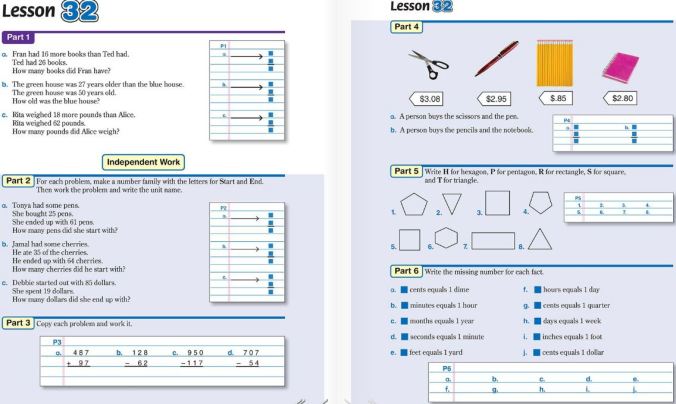
Then here’s another 15 minutes from that same lesson:
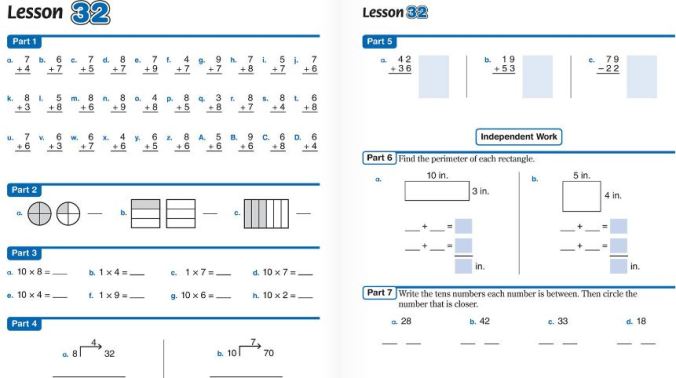
Look at the diversity of topics covered! Every lesson is like this. Compare it to the typical way we teach topics: 10 minute starter followed by 45 minutes on one single topic; next lesson, move on to the next topic in the scheme of work.
In contrast, in CMC lessons: whenever a new topic is introduced, it’s done in a 5-to-10-minute chunk, where one tiny concept is introduced, then tested. How are the concepts broken down? For example, look at ‘part 4’ in the picture directly above. The question for the pupils to answer here would be something like: ‘write the multiplication fact shown here’ = ‘8 × 4 = 32’ and then ‘write the division fact shown here’ = ’32 / 8 = 4′. The question is simply testing whether pupils remember the locations of the quotient, divisor and dividend – separate from any actual division. And that’s it! Those two questions will be all that the pupils will be asked to do – for this lesson. Compare that with the average lesson on bus-stop division – I don’t think I’ve ever explicitly taught all the meanings that are implied by a filled-out bus stop. No wonder it’s so hard to get bus-stop division to stick for our weakest pupils.
But that’s just one lesson. The real secret is what happens over time. As we’ve seen, each CMC lesson contains a smorgasbord of mathematical activity, but there’s a big range of guidance in them. If you look closer at the two example lessons above, you’ll see that some of the lesson falls under ‘independent work’, and others don’t. Over several weeks, some topics are introduced for the first time, in tiny incremental parts; the topic complexity is gradually increased, and teacher instruction/reminders/guidance is gradually pared back, until the questions become part of the independent work for the pupils to do without any help.
As a whole, this is how CMC approaches each topic. What CMC never does is what we normally do in UK maths lessons: assign a topic to a single lesson or two, get pupils to practice it in the lesson, then recap briefly in the following lesson and move on for good.
The reason we do things this way is because this method works well for a good proportion of a class (the ~60% who achieved C+), but it’s clear that some of the children are left behind by it, floundering in misconceptions – the pace might be too quick, or the concepts (like remainders) too confusing. So, the average teacher addresses this by differentiating the work, but this has numerous disadvantages – to take just a few examples, some pupils never get as far as short division (so when will they learn it?) because they are still practising finding remainders; teachers find it difficult because they are trying to teach 3 lessons in one. (I have written on some of the pitfalls of differentiation before.)
Instead, this is the CMC method of breaking down a topic and designing a curriculum:
- break down a topic into parts which are so simple that they are nearly-impossible to get wrong.
- Then, practice that broken-down topic for a few minutes. Then – that’s that topic DONE for the day.
- Instead, to progress pupils further in that topic, re-introduce it in future lessons, gradually scaling up complexity, and scaling back guidance. This may take place over 5 lessons, before the topic is attempted independently.
- Repeat steps 1-3 for other topics, and then put them together in the same lesson.
Does this work? The results, to me, speak for themselves: the pupils (who are among the weakest in the year) enjoy it because they experience a lot of success; they work hard in lessons; and finally, in the included assessments, they get 90%+ each time. They are making clear progress on numerous topics and accurately doing difficult maths that, 11 months ago, seemed totally beyond them. In other words, CMC is another example of a ‘success story’ in maths education that we must learn from.
How is it so successful? One of the key designers of CMC is Siegfried Engelmann, noted for his application of pedagogical research to real-world curriculum, and this is no different. Let’s take a deeper look at the theory behind CMC’s’s unorthodox distribution of practice in smaller chunks, spread over extended periods of time:
The spacing effect
Distributing practice over time, instead of blocking it all in one lesson, has a name: the spacing effect. What is the spacing effect? Here’s Daniel Willingham, cognitive scientist extraordinaire:
Suppose a student is going to spend one hour learning a group of multiplication facts. How should that hour be allocated? Should the teacher schedule a single, one-hour session? Ten minutes each day for six days? Ten minutes each week for six weeks? The straightforward answer that we can draw from research evidence is that distributing study time over several sessions generally leads to better memory of the information than conducting a single study session. This phenomenon is called the spacing effect.

The graph above shows the results of Keppel’s experiment: an experiment that compared two ways of allocating teaching time. The two bars on the left show test results (higher is better) when practice is massed – i.e. allocated in bulk within a single lesson. As you can see, there is a huge dropoff in results in a test done one week later, compared to a test done the following day. In contrast, the bars on the right show test results when practice is distributed – i.e. split up into much smaller chunks to be studied over multiple days. Notice how there is barely any dropoff at all in the two bars: results one week later are almost as good as the results the day after the instruction finished. In other words, if you were to spend a 1-hour lesson teaching a topic, and followed it up the next day with 10 successfully-answered recap questions, then don’t expect pupils to retain what they’ve learnt for even a week. But if you employ the approach of CMC, and instead split up that same instruction and practice into four 15-minute chunks practised over four days, then watch and see your pupils retain it, for at least a week.
So, in short, the spacing effect tells us that one of the best ways to teach for memory is to teach topics in small chunks over extended periods of time. It’s an effect that has been proven time and time again in research. But strangely we just don’t teach like this! I suspect, as hinted at before, it’s because teaching in blocks works fine for the majority of pupils. But at its core, the spacing effect doesn’t have to be as complicated or detailed as the CMC curriculum; instead, it offers a very simple prescription: if you want pupils to remember something, you must continually return to it, again and again and again. Every day for a week. Every other day for a month. And then once every week for the rest of the year.
Because the spacing effect really is that simple, we do see it employed in other aspects of maths education – especially when it matters the most. If your schools runs a Year 11 intervention, one aspect of it probably looks like this: take pupils out of form time for 10 minutes, give them a standard GCSE C-grade question type, let them try it, re-teach it if they don’t know how. Repeat daily with similar topics and different topics in that crucial run-up to Easter, and watch them magically ‘improve a grade’. Similarly, more intensive hour-long intervention sessions rarely look like the usual 60-minute mono-topic lesson; instead, they’ll be filled with multiple topics, with the questions changing every 10 minutes, to be repeated over weeks and months. Can you see what’s happening here? It’s none other than the spacing effect: little chunks, repeated often, leading to long-term memory, fluency, and confidence. Heads of maths departments know this works well (for the previous GCSE at least) for year 11 GCSE. But if this is a successful method, then why don’t we make steps to implement this all the way down the school? In KS3? Year 7, even, for our struggling pupils? Why on earth wait until year 11 – when, for many pupils, it’s too late – to use one of the most powerful effects for effective memorisation?

A great revision resource from mathedup.co.uk… but what if every lesson looked a bit more like this?
That’s partly a rhetorical question. I’m aware that one big reason why not every lesson can look like CMC or a Y11 intervention session is because they are a intensive to resource and prepare. But that doesn’t mean we can’t find ways of making greater use of the spacing effect without overhauling our entire curriculum. Here are some suggestions for September.
Practical applications of the spacing effect
Immediate applications across all topics
The easiest application that all teachers must do: don’t take the default approach to ‘recap starters’, where you only spend 10 minutes recapping what you did the previous lesson. Keppel’s experiment shows that while pupils will be pretty successful in retrieving whatever you learnt yesterday, this is no guarantee that they’ll be able to retrieve much of it in a week’s time. Especially if you’ve moved onto another topic, make it your aim to recap the previous topic’s work on a daily basis for at least a week. Aside from the usual ‘5 minute recap of the previous lesson’, devote an extra 10 minutes of each lesson to wider recap: recap the previous topic, the topic before that, the topic before that too. Finished sequences and moved onto volume? Spend the next week, or even better, fortnight, devoting 10 (then decreasing to 5) minutes each lesson on sequences questions that they’ve answered before. Keep it minimal and sustainable – for example, just re-project the exact same practice questions of the sequences powerpoint you used before, or re-use questions from the previous week’s worksheets.
A good heuristic to see if you’re recapping frequently enough is if pupils can do it with as little guidance and prompting as possible. If, during recap, you find you’re effectively having to re-teach a topic from scratch, that’s a clear sign that you’ve left the topic untouched for far too long.
I wish I’d known this and made a better effort at doing this right from the start of my teaching career. The spacing effect research tells us it’s worth it.
Create starter booklets/infinite worksheets for high-leverage topics
High-leverage topics are those upon which many other topics hang: for example, written operations, fractions, negatives, simplifying algebra, equations, and so on.
We want our pupils to be 100% confident in such high-leverage topics. We want these topics to be ingrained in their minds. So, we ought to make use of the spacing effect. Since the spacing effect requires practice over long periods time, we want an easy way of having enough practice questions of increasing complexity to use on a daily basis. An easy way to get in enough practice without having to plan too far is to create starter booklets in advance: 10 minutes, every day, focused on practising key high-leverage skills.
William Emeny’s Numeracy Ninjas booklets are a brilliant free resource – we use them as our starter booklets for year 8. Similarly, setting Times Table Rock Stars as a daily homework over several terms is also a key foundation for future maths success. At Michaela, we’ve also sensed the need for something in between the two – TTRS focuses purely on multiplication & division facts, whereas Numeracy Ninjas aims to hit around 25 different key skills with just 1 question per topic per day. So we also occasionally make our own starter booklets for certain topics too.
I’ve uploaded one example of such a booklet, used with a bottom set Y7 class, on TES here. Of course, it doesn’t have to be printed out as a booklet – projecting it also works. Either way, I’d recommend making them using random number generators in Excel, so you have an infinite variety of suitable questions, ready to project at a moment’s notice. And once you’ve gotten the hang of using Excel, and the pupils have gotten the hang of these questions, it’s really easy to increase or decrease the complexity of your question set. Other topics we’ve made booklets for include lots of practice with operations with negatives, decimal multiplication, and fraction operations. Or really, whenever you stumble upon a topic that your pupils keep on forgetting, just make a starter booklet! Give them 5 minutes of practice every lesson for a term, and complain no more.
Using the spacing effect to teach grammatical topics
The spacing effect also comes in very useful for those topics that are difficult to learn, and so easily confused and forgotten – in a previous blog I have called them grammatical topics, As I wrote before:
The common issue with grammatical topics: just like the usage of full stops, they are easy to explain & understand poorly and very difficult to explain and understand comprehensively. There’s too much underlying logic that pulls in different directions. So, I’m increasingly convinced that with grammatical topics in maths, just as with language, understanding must follow grammatical fluency and familiarity. Our understanding of them requires a mass of examples, together with a mass of practice, cohering together, over a stretch of time.
The final words ‘over a stretch of time’ are another way of saying: employ the spacing effect!
The same strategies I mentioned in that post come in handy here, too, so give it a read if you haven’t – in fact, I was really implicitly recommending the spacing effect there. The practical tips mentioned were:
- Reflect on how ‘grammatical’ the topic you want to teach is
- Start slow, build up
- Practice, practice, practice – over time
- Prepare to fly
Before I dive into more detail on these points, the first step is to be aware of your teaching group. Top sets generally do fine with traditional blocked practice plus recap and the odd revision lesson. Indeed, top sets generally find grammatical topics (like negatives, simplifying algebra, number work) pretty easy and intuitive. But middle sets would benefit more, and bottom sets would benefit most extensively, from a teaching approach that employs the spacing effect. That may determine how much you want or need to overhaul your resources.
So what does this look like? Here’s an example of how I taught bus-stop division, using lots of Excel random-number question generators, to my bottom set year 7 group:
- Ensure 100% confidence with division-facts: 10 minutes for two lessons.
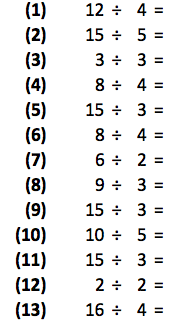
- Ensure 100% in finding remainders. 10 mins over three lessons, overlapping with the previous lessons.
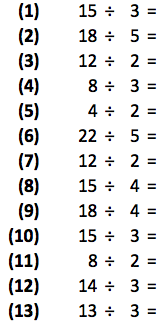
- Ensure 100% confidence in distinguishing the different answers when the divisor is bigger or smaller than the dividend. This was 10 mins over several later lessons. This was done with a mixture of these two layouts, to introduce to bus stop notation:
- Now, several lessons in, start to introduce the bus stop method, starting with questions where the answer is an integer. 15-30 mins over three lessons, again with some overlap with the previous lessons.
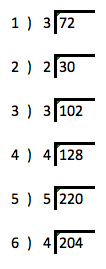
- Questions where division where the dividend is a decimal, to introduce pupils to having to add decimal points to their answer. 10 mins over three lessons, again with some overlap with the previous lessons.
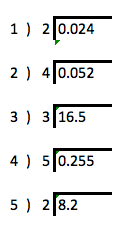
- Questions where the answer is a decimal of one decimal place. (E.g. 47 ÷ 5 and 34 ÷ 4. No pictures from here, as I think you get the picture!)
- Questions where the answer is a decimal of multiple decimal places. (E.g. 255 ÷ 8)
- And finally, after several teaching chunks of understanding and using recurring notation, questions where the answer is a recurring decimal. (E.g. 124 ÷ 3, 235 ÷ 6)
Notice what’s different about the time allocation: instead of trying to fit all 8 of these question types into two or three hours’ worth of lessons, I spread them out in smaller chunks over 2 weeks of lessons, and it probably didn’t take that much longer in terms of actual time. If I had tried to ram all those teaching points into three consecutive lessons, some of my pupils would’ve gotten it all, but many more would’ve gotten stuck early on (and in my earlier days, I would have ‘differentiated’ to “solve” the problem: ‘okay, if you’re finding these new questions on recurring decimals hard, do more practice on these other types that you were finding hard before!’). That’s one big thing CMC taught me, and I’m very grateful for it – in our end of year assessment, the division question was well-answered by most of my class.
Design a spaced curriculum
I’ve left this one til last because it’s by far the most work, but it’s potentially the most rewarding. The three suggestions I’ve made above are somewhat ad hoc. But why not space practice throughout an entire curriculum? This is what Engelmann and co. did for CMC; my one flaw with it is that it’s designed for the US curriculum. I’d love to see an equivalent version that’s geared towards UK’s GCSE maths specification, or even KS2 SATs. An easier version of this may also be the topic of my next post, so stay tuned.
Summary
The spacing effect is one of the strongest effects in memory research. Yet we don’t use it nearly enough. Our failure to make more of it is at the heart of much of the performance-learning gap: pupils can follow what we tell them to do in a lesson, but because we fail to revisit and re-practice over time, pupils’ lesson performance doesn’t turn into learning that endures in the long or even medium term. As I realised at the end of my first half-term as a teacher, this is disastrous for our pupils’ maths attainment, and thus their mathematical confidence and competency.
To improve maths results and fight off forgetting, we need to implement spaced repetition of practice throughout our teaching. I’ve suggested several methods we can do this:
- Increase the proportion of lesson time allocated to recap
- Make use of and create starter booklets to ensure spaced practice of high-leverage topics
- Use spaced practice to teach difficult grammatical topics over longer periods of time
- Create a spaced curriculum
In summary, real learning happens with focused practice, repeated constantly over time. It’s an intuitive insight – if you’ve ever learnt an instrument, or some skill, you’ll know this. The same is true of maths. Yet the way we teach maths is a bit like expecting a beginner musician to gain mastery of their instrument by learning a new piece every lesson. We must stop! And hopefully, in doing so, pupils will re-discover the music in the mathematics: the joy of playing a certain chord, again and again, the happiness found in repeating a favourite riff for a few minutes, the delight in focusing on nailing one particularly difficult phrase. I’ve seen it with my own pupils – the way they light up when they get to practise a drill; their celebrations when they get every question in the drill correct; the joy they get in knowing beyond a shadow of a doubt that they have mastered a very particular skill.



Pingback: Is this the best we can do? Part 6: the problem of forgetting | mathagogy
An excellent blog! I wonder if this also works when teaching English?
LikeLike
I’m sure it does! Have a look at Joe Kirby’s blog – lots of posts on memory and knowledge curriculum in English, e.g. https://pragmaticreform.wordpress.com/2013/11/16/memory/
https://pragmaticreform.wordpress.com/2013/12/07/skills-knowledge-debate/
LikeLike
This is a great post and I wish more maths was taught this way, and more schemes of work were drawn up with spacing in mind. I feel that the “spiral” curriculum is rarely twisted tight enough, and too long is left before topics are touched again. But a doubt nags: while we can “get away with it” with for higher sets or higher-level qualifications, does that mean we *should*? Could we deepen understanding, build long-term memory, and boost attainment by applying spacing techniques elsewhere? Is there evidence that they would still be as effective?
Even university students struggle to retain knowledge as they work through their degree, as was discussed under your previous post, so this is by no means a problem limited to KS3 and KS4 lower sets. Every A-level teacher knows that sinking feeling when you mark the half-term test on the last three chapters of the book, to find that even the basic recall questions from the first two of those chapters have slipped beyond the realm of human capability.
If you’re busy teaching differentiation rules, you aren’t recapping trig identities. That is unless you make a conscious effort to slip in regular recall tests (which is what I tried to do), but in principle I can see no reason you couldn’t interleave the topics more thoroughly rather than teach them in blocks in the first place. What stops us teaching the reciprocal and Pythagorean trig identities at the start of a lesson, and quotient rule in the second half? You could even tie two threads together by finishing off with how to differentiate cosec x = 1/sin x, but I don’t think scheduling needs to built around seeking such synergies.
If you design your scheme of work with chapters running in parallel, you could go the whole half-term without letting either topic rest unattended. I’ve never seen this tried, but I’d love to know how well it could be made work. As A-level becomes non-modular and you need to keep the material ticking over for two years, it seems to me that spacing and other memory research are more vital than ever.
LikeLiked by 1 person
“Spaced overlearning” is the variation of the spacing effect that is recommended by cognitive scientists to learn math most effectively and efficiently. Most math is “verbatim” (exact) knowledge which needs to be learned a bit differently than topics such as history or economics. In math, the goal is “automaticity” in recall; achieved by spaced learning to the point of PERFECT recall repeatedly. See http://arxiv.org/abs/1608.05006
LikeLiked by 2 people
I’m a piano teacher in the U.S. who found my way to your blog via the Learning Scientists. There are so many parallels between your math curriculum and the best way to teach music! As I read, I found myself comparing your descriptions to my own lesson plans and long-term goals for students. I was tickled to read your conclusion and I whole-heartedly agree!
However, most piano teachers don’t create lesson plans or plan long-term for their students. Many do expect beginners to learn 1 – 3 new pieces every week. They teach repertoire only and never think about breaking pieces down into the constituent concepts & skills. “Talented” students do okay with this type of teaching, but average students flounder (and quit). This bothered me when I started teaching. Why can’t I teach in a way that helps everyone succeed? Like you, I have found that if I prepare students by teaching the concepts & skills in advance over several weeks, a little bit at a time, all of my students are successful.
LikeLiked by 1 person
Hi Hin-Tai! Amazing blog. One quick question…
I can see how this is better than a topic based approach. However, I’m still not sure how kids who already have the skills covered are moving forward? Surely there are some students in your classes for which these tasks don’t stretch them? And surely there are some for whom this isn’t a challenge at all? Or do you just stream classes?
Best.
Ollie.
LikeLike
Thanks Ollie..
Two responses: I believe in streaming, so that eliminates some of the problem. Secondly, your question is still valid in this context. Several responses come to mind. Firstly, I think we overestimate the degree to which students have mastered the skills we teach them – the learning / performance distinction comes in handy here, as does the concept of overlearning. I think a huge downside of the narrative of ‘moving forward’ and ‘all groups of learners making progress’ is that it doesn’t recognize the importance of overlearning. A quote I really like is: ‘don’t practise until you get it right, practise until you can’t get it wrong’. How often do we really give pupils the chance to master a skill to that extent?
Secondly, that said, sometimes there are some skills which pupils have truly mastered. This is often the case for the drills I posted on TES, linked in my blog. Since the focus with those skills is getting them to automaticity, those same pupils will often be the fastest at completing a drill, after which I will put up a nice challenge question for them to do whilst everyone else is finishing off the drill. I’ll often reward speed and accuracy with merits and praise, too, to emphasise the importance of overlearning and mastery – this means that the kids are motivated to get even better in terms of speed, and still enjoy the drill, even though they feel pretty confident with the topic. Hope that helps.
LikeLike
Pingback: Teaching and learning– what actually works? | Reflections of a science teacher…
Pingback: Infinite Worksheets – Trans Teacher (in Training)
Reblogged this on The Echo Chamber.
LikeLike
Hi Hin-Tai,
This blog post has really inspired me. Thank you.
I used this idea of spacing and trying to fit 4 or 5 topics into every lesson a couple of years ago with a low ability year 11 class. It was successful but I haven’t repeated it with other low ability groups from other year groups and I think the reason is partly the amount of work required to pull it off.
However, I am going to be teaching a low ability year 7 class next year (possibly 2) and think that the connecting maths concepts books look perfect. The problem is that getting the books is proving tough. I have a couple of questions I am hoping you can answer.
1. What books/level would you recommend starting with?
2. How did you get them? (the website says they only ship to US locations)
Thanks
Matthew
LikeLike
Hi Matthew,
Thanks for the kind comments. I haven’t ordered them myself, so the best person to ask might be my HoD! dquinn at mcsbrent dot co dot uk.
It’s worth knowing too: the connecting maths books are great but expensive, and come with a workbook that can only be used once. At Michaela we only use it with our intervention group – the absolute weakest 10 pupils in the entire year. So it’s hard for me to recommend what level to start with! I’d recommend a really careful preview through as much of it as possible – I haven’t tried using it in a whole class setting and I can foresee some difficulties that there might be in that case. That said, it was designed as a whole class resource too! The sad thing, as you say, is that there is no alternative that employs spacing to quite the degree that it does – as you say, it’s a huge amount of work to design. Hope that’s helpful!
LikeLike
Absolutely fascinating stuff. I am going to try a variation of this with my weaker Y5 group. How do you think it would work if I taught the entire group the whole concept, but then with the weaker group, only gave them a certain number of questions on that concept? The rest of the questions would be a range of topics in which they struggle?
LikeLike
Hi Hin-Tai
I wanted to let you that I read all your posts in this series and thought they were great. Is This The Best We Can Do? was a sentiment that absolutely resonated with me, and I thought your analysis and commentary was spot-on. At the time I was teaching maths in a school where each pupil had an iPad and whilst there were lots of iPad activities that added colour to a lesson, and some that added significantly more, I really felt there wasn’t the app that addressed the issue of forgetting. It was when I was teaching straight-line graphs (one of my favourite topics and I used to think I taught it well!) to Years 7, 8, 9 and 10 with almost exactly the same content that I reached my limit. So I set about creating an App that used a lot of the ideas you talk about in this blog. I’d thought about it for a while, but as you know, there is no spare time when teaching. So in the end I resigned and got on with it. It has taken far far longer than I thought it would but it got approved by Apple last week and is now on the App Store for iPads called Arc Maths. The website is a bit theory light but is http://www.arceducation.co.uk and explains how the App works but in essence it is personalised retrieval practice that incorporates the spacing effect and interleaving. I think it could be really effective, but I’ll just have to wait and see if there is any take up. If you are in any way interested and have an iPad I can set you up with free access. Just get in touch.
Anyway I just wanted to let you know that you played a part in it . Your blog crystallised my own thoughts and spurred me into action. So thank you.
With best wishes
Rachel Dunsmore
LikeLike
Thanks for getting in touch Rachel! I’m so glad the blogs were helpful. I don’t have an iPad, I’m afraid, but I do wish you every success for Arc Maths. Well done for getting it off the ground!
LikeLike
Hi there,
It looks amazing .. this all incredibly interesting .. is there a non i pad version.. perhaps laptop.. any smartphone?
Thanks
LikeLike